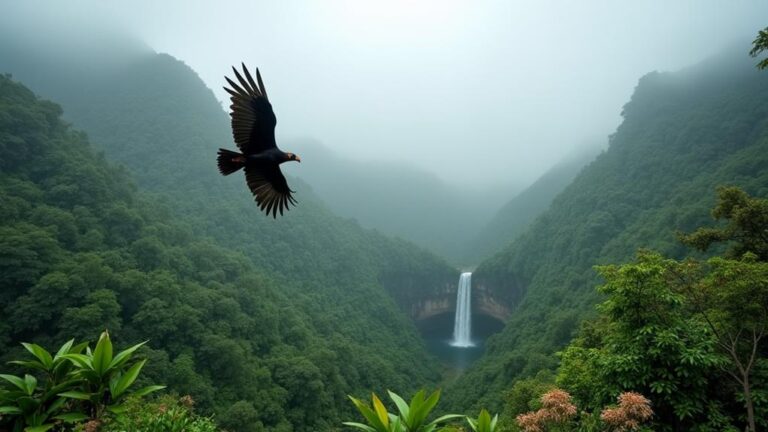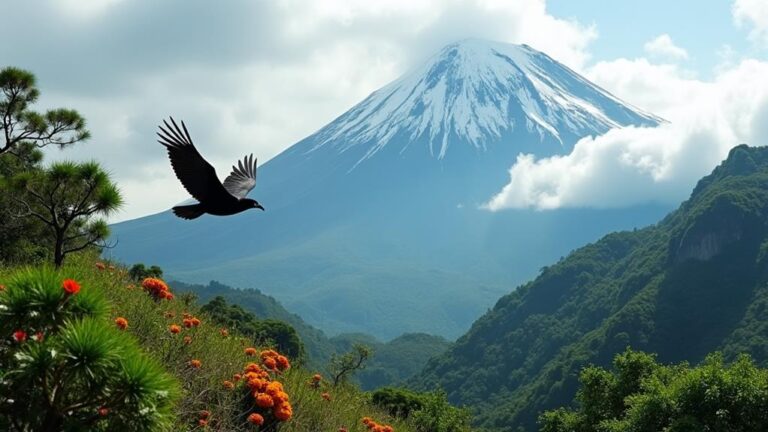As you venture into Iberá National Park, you'll find yourself surrounded by a tapestry of ecosystems, each one teeming with life. You'll catch glimpses of vibrant birds like the scarlet ibis, and maybe even spot a caiman basking in the sun. But it's not just the wildlife that's remarkable – the park's diverse landscapes, from lush rainforests to vast savannas, are a monument to the region's unique geological history. And yet, despite its natural beauty, Iberá remains somewhat of an enigma. You can't help but wonder what secrets lie hidden beneath its tranquil surface, waiting to be uncovered.
Contents
Key Takeaways
- Iberá National Park is home to diverse and unique wildlife, including caimans, capybaras, and over 350 bird species.
- The park features diverse landscapes, including rainforests, savannas, and geological formations like the Sierra de San Rafael mountain range.
- The Iberá Wetlands are a haven for aquatic plants, fish, and birds, providing a habitat for diverse species.
- Conservation efforts focus on protecting the park's ecosystems from human activities, climate change, and habitat destruction.
- Visitors can plan their trip by familiarizing themselves with park regulations, stopping by Visitor Centers, and considering the time of year and weather conditions.
Unique Wildlife of Iberá
As you venture into Iberá National Park, you're likely to encounter an astonishing array of wildlife that's as unique as it's fascinating.
The park is home to numerous rare species that have adapted to the region's distinct environment. One of the most iconic inhabitants is the caiman, a reptile that's perfectly suited to the park's wetlands. Its scaly skin and powerful tail allow it to thrive in the murky waters.
Another remarkable example of animal adaptations is the capybara, the world's largest rodent. These gentle giants have developed webbed feet and can hold their breath underwater for up to five minutes, making them well-suited to the park's aquatic environment.
The park is also a haven for birdwatchers, with over 350 species documented, including the majestic jabiru stork and the vibrant scarlet ibis.
As you explore Iberá National Park, you'll have the opportunity to observe these incredible creatures up close, gaining a deeper appreciation for the intricate relationships between the park's unique wildlife and their habitats.
Diverse Landscapes and Ecosystems
Ranging from lush rainforests to vast savannas, Iberá National Park's diverse landscapes and ecosystems are a marvel to behold. As you explore the park, you'll encounter unique geological formations, such as the Sierra de San Rafael mountain range, which gives way to rolling hills and vast plains. The park's varied landscapes support an incredible array of ecosystems, including tropical forests, grasslands, and wetlands.
| Ecosystem | Characteristics | Environmental Threats |
|---|---|---|
| Tropical Forests | Dense canopy, exotic species | Deforestation, habitat fragmentation |
| Grasslands | Open plains, diverse wildlife | Overgrazing, invasive species |
| Wetlands | Aquatic habitats, migratory birds | Habitat destruction, pollution |
As you dig deeper into the park, you'll discover the intricate connections between these ecosystems and the environmental threats they face. Human activities, such as agriculture and urbanization, pose significant risks to the park's delicate balance. Preserving Iberá National Park's diverse landscapes and ecosystems for future generations is vitally important.
Exploring the Iberá Wetlands
Wetlands, often referred to as the "kidneys of the earth," play a pivotal role in maintaining ecological balance, and Iberá National Park's wetlands are no exception.
As you venture into these Wetland wonders, you'll discover a world teeming with life. The park's wetlands are a haven for aquatic plants, fish, and birds, providing a habitat for a diverse range of species.
Local legends speak of the mystical powers of the wetlands, believed to have healing properties and spiritual significance.
As you explore the Iberá Wetlands, you'll have the opportunity to observe caimans, capybaras, and anacondas in their natural habitat.
The wetlands' unique ecosystem supports an astonishing array of plant life, including giant water lilies and floating islands of vegetation.
Take a guided boat tour or hike along the wetland trails to experience the tranquility and majesty of this unique environment.
With each step, you'll uncover the secrets of the Iberá Wetlands, and gain a deeper appreciation for the importance of preserving these delicate ecosystems.
Conservation Efforts and Challenges
The Iberá National Park's conservation efforts focus on protecting the delicate balance of its ecosystems, where human activities and natural processes intersect.
You'll notice that park rangers and conservationists work tirelessly to mitigate the impact of human activities on the environment. Human impact, such as habitat destruction, pollution, and overfishing, poses a significant threat to the park's biodiversity.
Climate change also plays a significant role, altering water levels and disrupting the natural cycles of the wetlands.
To combat these challenges, the park has implemented various conservation strategies.
For instance, you'll see efforts to restore degraded habitats, reintroduce native species, and promote sustainable land-use practices among local communities.
Additionally, the park collaborates with researchers to monitor the effects of climate change and develop effective adaptation strategies.
Planning Your Park Visit
As you prepare for your Iberá National Park adventure, a well-planned itinerary is key to revealing the park's secrets and making the most of your time.
Before you start exploring, familiarize yourself with the park's regulations. Understand that certain areas may be closed due to conservation efforts or wildlife protection, and respect any restrictions in place.
Stop by one of the park's Visitor Centers to gather valuable information and insights from park rangers.
These centers offer maps, brochures, and exhibits that'll help you navigate the park's vast terrain and identify the best trails, scenic viewpoints, and wildlife watching spots.
You can also inquire about guided tours, which can greatly enhance your experience.
When planning your itinerary, consider the time of year, weather conditions, and your physical abilities.
Be sure to pack essential gear, including comfortable hiking shoes, sunscreen, and insect repellent.
Frequently Asked Questions
Are There Any Accommodation Options Within Iberá National Park?
When venturing into a national park, you'll find limited accommodation options within the park's boundaries. However, Iberá National Park offers luxury lodges and eco-camping sites, allowing you to connect with nature while still enjoying comfort and amenities.
Can I Bring My Pet to the National Park?
When planning a trip, you'll want to check pet rules and animal restrictions beforehand, as many parks have strict guidelines; unfortunately, you won't be able to bring your furry friend to Ibera National Park, as pets are not allowed to preserve the natural habitat.
Are There Guided Tours Available for Solo Travelers?
When you're flying solo, it's best to have a game plan; fortunately, guided tours are available for solo adventurers like you, making park navigation a breeze, and ensuring you get the most out of your experience.
Is Wi-Fi and Phone Signal Available in the Park?
You'll find that rural areas often struggle with connectivity, but you'll be relieved to know that mobile access is improving, with some providers offering decent coverage, though speeds might be slow, and Wi-Fi is usually limited to lodges and visitor centers.
Can I Fish in the Wetlands and Lakes of Iberá?
When fishing in wetlands and lakes, you'll typically need fishing permits to guarantee sustainable practices and protect the ecosystem. In the case of Iberá, permits are required to promote wetland conservation and responsible angling.
Conclusion
As you leave Iberá National Park, the memories of its majestic landscapes and diverse wildlife will linger. Will you ever forget the sight of a scarlet ibis taking flight or the gentle gaze of a capybara? The park's intricate relationships between species and habitats will stay with you, inspiring a deeper appreciation for nature's harmony. Take the lessons learned from Iberá with you, and remember, the preservation of our planet's wonders depends on our collective efforts.









